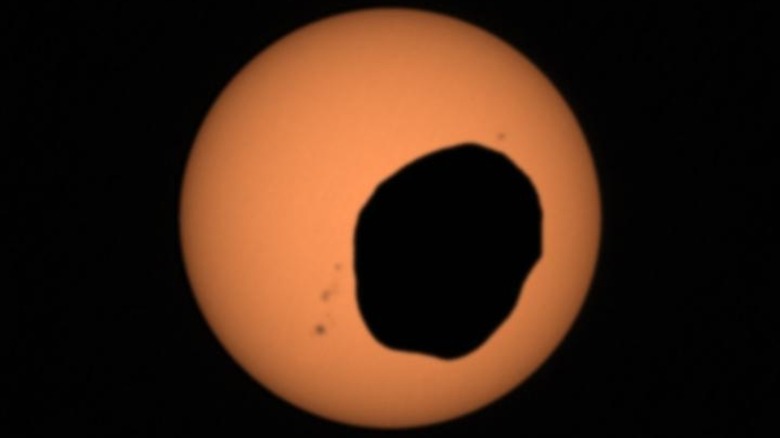See Stunning Footage Of A Solar Eclipse On Mars
While we sit on Earth, looking out to other planets, at least one observer is sitting on Mars and is looking up at space itself. The Perseverance rover recently captured footage of a solar eclipse as seen from Mars, when the Martian moon Phobos passed in front of the sun. Perseverance used the camera on its Mastcam-Z instrument to record the event, which happened on April 2, or the 397th Martian day of the mission. The eclipse didn't last long — just over 40 seconds — because Phobos is much smaller than Earth's moon. As it passes in front of the sun you can see its irregular shape, which is slightly elongated; or, as NASA's Jet Propulsion Laboratory (JPL) puts it, "potato shaped."
This is the most detailed recording of a Phobos solar eclipse with the and highest frame rate taken to date, all possible due to the camera in Mastcam-Z, which is the rover's primary science camera. It is an updated version of the camera on NASA's other current Mars rover, Curiosity, which has a new zoom function (via NASA). This helped to capture the eclipse in unprecedented detail. "I knew it was going to be good, but I didn't expect it to be this amazing," Rachel Howson, one of the camera operators, said (via JPL). Howson's team first saw low-resolution versions of the images, then were delighted by the arrival of the high resolution images. "It feels like a birthday or holiday when they arrive. You know what's coming, but there is still an element of surprise when you get to see the final product."
Learning about Mars's moon
Mars has two moons, Phobos and Deimos. Studying them via solar eclipse can reveal surprising information about the planet which they orbit. Even though Phobos is only 17 miles across, it does orbit close to the planet's surface (via NASA). There are two-way effects caused by this: Phobos exerts a pull on Mars's interior, and Mars is slowly pulling Phobos closer over time. By looking at this relationship, researchers can understand more about the interior of Mars (via JPL). Eventually, Phobos will come too close to the surface of Mars and be destroyed. But there is a theory that this may not be the end of the story, as the moon could be pulled apart into small chunks and form rings around the planet in around 70 million years' time. There may even be a cycle with Mars switching between moons and rings over huge timescales (via NASA).
For now, researchers will admire the footage of Phobos passing in front of the sun and use it to gather as much data as they can about this moon. "You can see details in the shape of Phobos' shadow, like ridges and bumps on the moon's landscape," said Mark Lemmon, a longtime Phobos researcher (via JPL). "You can also see sunspots. And it's cool that you can see this eclipse exactly as the rover saw it from Mars."
